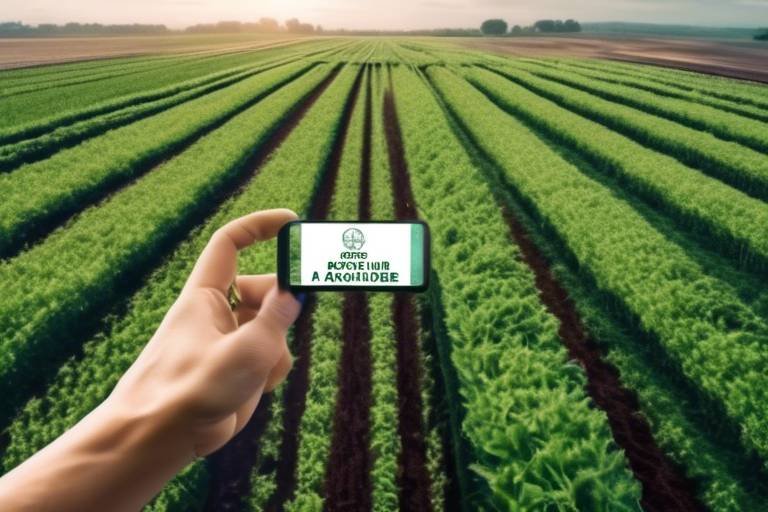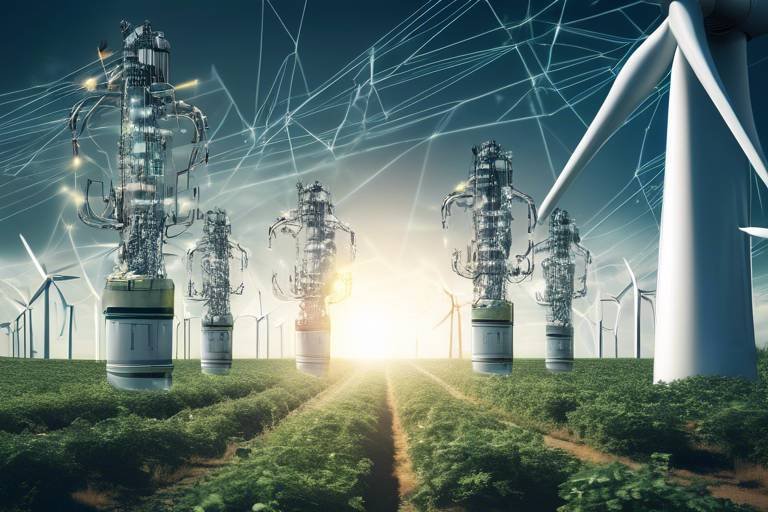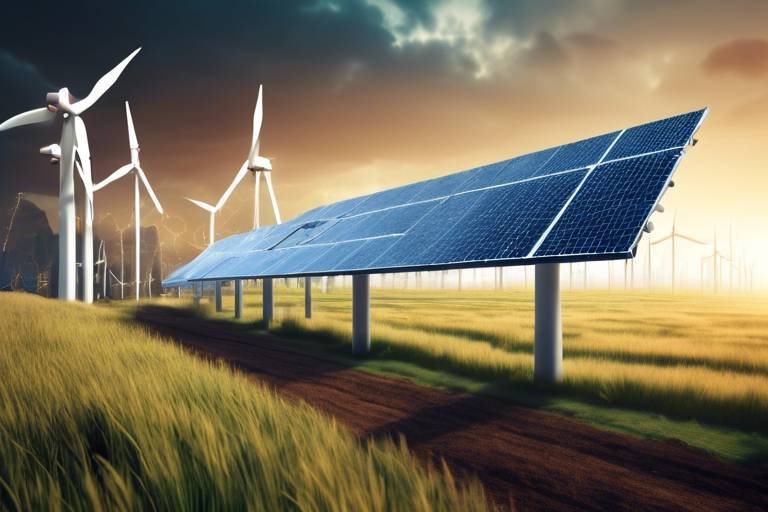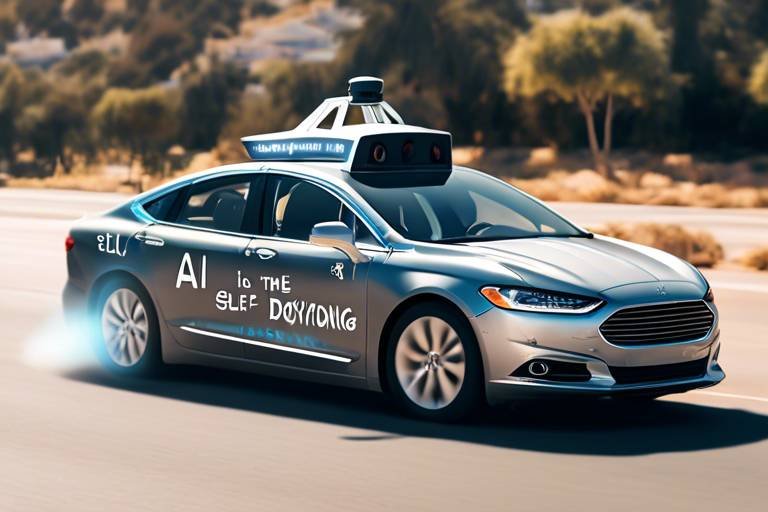AI in Agriculture: Predictions for the Future
As we stand on the brink of a technological revolution, the agricultural sector is experiencing a seismic shift thanks to artificial intelligence (AI). This isn't just about robots in fields; it's about a complete transformation in how we grow our food, manage resources, and ensure sustainability. Imagine a world where farmers can predict crop yields with pinpoint accuracy, manage pests before they become a problem, and use resources like water and fertilizers with unparalleled efficiency. Sounds like science fiction, right? But it's happening now, and the future looks even more promising.
AI in agriculture is not merely a trend; it's a necessity driven by the increasing global population and the urgent need for sustainable practices. With an estimated 9.7 billion people expected by 2050, the demand for food will skyrocket, putting immense pressure on our farming systems. Here’s where AI steps in, acting as a powerful ally in maximizing productivity while minimizing environmental impact. By leveraging data analytics, machine learning, and automation, AI is set to redefine traditional farming practices.
One of the most exciting aspects of AI in agriculture is its ability to analyze vast amounts of data. Farmers can now utilize predictive analytics to forecast everything from crop performance to potential pest outbreaks. Imagine having a crystal ball that tells you when to plant your seeds or when to apply pest control measures. This data-driven approach empowers farmers to make informed decisions, ultimately leading to higher yields and reduced waste.
Moreover, the integration of AI technology is not limited to small-scale farms; it has the potential to revolutionize large agricultural enterprises as well. With the advent of precision agriculture, farmers can use drones and sensors to monitor crop health in real-time. These technologies provide invaluable insights into soil conditions, moisture levels, and nutrient requirements. Not only does this enhance crop management, but it also allows for more targeted application of resources, which is crucial for sustainability.
As we look to the future, we can expect AI to play an even larger role in automating farming equipment. The rise of robotics and autonomous machinery is set to transform labor efficiency in agriculture. Picture a field where drones are planting seeds, robots are harvesting crops, and automated tractors are tilling the land—all while farmers monitor everything from their smartphones. This level of automation not only saves time but also reduces human error, leading to better outcomes overall.
However, AI's impact goes beyond just improving efficiency. It has the potential to revolutionize pest and disease management. By utilizing AI systems, farmers can detect early signs of infestations or diseases, allowing for swift intervention. This proactive approach can drastically reduce crop loss and the need for harmful pesticides, promoting a healthier ecosystem.
In conclusion, the future of AI in agriculture is bright and full of possibilities. With its ability to enhance productivity, promote sustainability, and streamline farming practices, AI is poised to become an indispensable tool for farmers around the globe. As we embrace these technological advancements, we must also focus on integrating them responsibly to ensure a sustainable future for our planet and its inhabitants.
- What is AI in agriculture? AI in agriculture refers to the use of artificial intelligence technologies to improve farming practices, enhance productivity, and promote sustainability.
- How does predictive analytics help farmers? Predictive analytics helps farmers forecast crop performance and pest outbreaks, enabling them to make informed decisions for better crop management.
- What are precision agriculture techniques? Precision agriculture techniques involve using advanced technologies like drones and sensors to monitor crop health and optimize resource allocation.
- Can AI help with sustainability in farming? Yes, AI can promote sustainable farming practices by reducing waste, conserving resources, and improving environmental protection.

The Role of AI in Modern Farming
Artificial Intelligence (AI) is not just a buzzword; it's a game-changer in the world of agriculture. Imagine a farmer equipped with the ability to predict weather patterns, monitor crop health, and manage resources with unparalleled precision—all thanks to AI technologies. This isn't science fiction; it's happening right now! The integration of AI into modern farming practices is enhancing efficiency, increasing crop yields, and optimizing resource management. But how exactly is this transformation taking place?
At its core, AI in agriculture enables farmers to make data-driven decisions. By analyzing vast amounts of data from various sources, AI systems can provide insights that were previously impossible to obtain. For instance, farmers can utilize AI to analyze soil conditions, weather forecasts, and even market trends, allowing them to plant at the optimal time and choose the best crops for their specific conditions. This level of insight not only boosts productivity but also reduces waste, making farming more sustainable.
One of the most significant applications of AI in farming is through the use of predictive analytics. These tools can forecast crop performance and identify potential pest outbreaks before they become a problem. Imagine knowing a week in advance that a pest is about to invade your fields. This kind of foresight allows farmers to take preventive measures, saving them time, money, and resources. For example, AI can analyze historical data and current environmental conditions to predict when pests are likely to strike, allowing farmers to apply treatments strategically rather than reactively.
Additionally, AI technologies are paving the way for precision agriculture. This approach uses AI to enhance farming precision by employing tools like drones and sensors. Drones equipped with advanced imaging technology can survey large areas of farmland, capturing data on crop health and soil conditions. This information is invaluable for farmers, as it helps them make informed decisions about irrigation, fertilization, and pest control. The result? More efficient use of resources and a healthier crop yield.
Furthermore, the rise of automated farming equipment is another area where AI is making waves. Robotics and autonomous machinery are transforming labor efficiency in the agricultural sector. For instance, self-driving tractors can plow fields and plant seeds with minimal human intervention, freeing up farmers to focus on other essential tasks. This not only reduces labor costs but also minimizes human error, leading to better outcomes in crop production.
In summary, the role of AI in modern farming is nothing short of revolutionary. From predictive analytics to precision agriculture and automated equipment, AI technologies are enabling farmers to work smarter, not harder. As we look to the future, the potential for AI to further transform agriculture is limitless, making it an exciting time to be involved in this vital industry.

Predictive Analytics for Crop Management
In the ever-evolving world of agriculture, predictive analytics powered by artificial intelligence is emerging as a game-changer for farmers. Imagine being able to foresee the future of your crops, predicting not just their growth but also potential challenges like pest outbreaks or adverse weather conditions. This is not science fiction; it's the reality of modern farming. By leveraging vast amounts of data, AI algorithms can analyze trends and patterns that are invisible to the naked eye, enabling farmers to make informed decisions that can significantly improve crop yields.
At its core, predictive analytics involves the use of historical data combined with machine learning techniques to forecast future events. For farmers, this means they can anticipate challenges and opportunities alike. For instance, if data indicates that a particular pest tends to appear during a specific season, farmers can prepare in advance, applying preventive measures rather than reacting after the damage is done. This proactive approach not only saves time and resources but also enhances overall productivity.
One of the most exciting aspects of predictive analytics is its ability to provide data-driven insights that can transform traditional farming practices. Farmers can utilize these insights to optimize their planting schedules, irrigation practices, and even fertilization techniques. For example, a farmer can analyze weather patterns and soil moisture levels to determine the best time to plant seeds, ensuring that they are sown under optimal conditions. This level of precision can lead to healthier crops and higher yields.
To further illustrate the impact of predictive analytics in crop management, consider the following table that outlines some key benefits:
| Benefit | Description |
|---|---|
| Improved Decision Making | Farmers can make informed choices based on predictive models, reducing uncertainty. |
| Resource Optimization | Better allocation of resources like water and fertilizers, leading to cost savings. |
| Pest Management | Early detection of potential pest issues allows for timely intervention, minimizing crop loss. |
| Yield Prediction | Accurate forecasts of crop yields help farmers plan for storage and sales effectively. |
Moreover, AI-driven predictive analytics can also facilitate collaboration among farmers. By sharing data and insights, farmers can create a collective intelligence network that enhances the overall farming community's resilience. This is particularly important in regions where agriculture is heavily impacted by climate change. With shared knowledge, farmers can adapt more quickly to shifting environmental conditions, ensuring that they remain competitive in a rapidly changing market.
As we look to the future, the integration of predictive analytics in agriculture is only expected to grow. With advancements in technology, farmers will have access to even more sophisticated tools that can analyze data in real-time, providing instant feedback and recommendations. This will not only empower farmers but also contribute to a more sustainable agricultural system, where decisions are based on solid data rather than guesswork.
In conclusion, predictive analytics is not just a trend; it's a vital component of the future of agriculture. By harnessing the power of AI, farmers can transform their practices, making them more efficient and sustainable. As technology continues to advance, the possibilities for predictive analytics in crop management are boundless, paving the way for a new era of farming that is smarter, more responsive, and ultimately more productive.
- What is predictive analytics in agriculture? Predictive analytics in agriculture refers to the use of data analysis techniques to forecast future agricultural outcomes, helping farmers make informed decisions.
- How does AI improve crop management? AI improves crop management by analyzing data to predict crop performance, pest outbreaks, and optimal planting times, leading to better resource allocation and increased yields.
- Can predictive analytics help with pest management? Yes, predictive analytics can identify patterns in pest behavior, allowing farmers to implement preventive measures before infestations occur.

Machine Learning Applications
When it comes to revolutionizing agriculture, machine learning stands out as a game-changer. Imagine a world where farmers can predict crop yields with pinpoint accuracy or detect soil health issues before they become significant problems. This isn’t just a dream; it’s happening right now, thanks to the power of machine learning algorithms that sift through vast datasets to provide actionable insights. These algorithms can analyze everything from historical weather patterns to soil composition, ultimately allowing farmers to make informed decisions that enhance productivity.
One of the most exciting applications of machine learning in agriculture is in the area of yield prediction. By examining past data on crop performance, weather conditions, and even market trends, machine learning models can forecast future yields. This capability is crucial for farmers as it helps them plan their planting schedules, manage resources, and even negotiate better prices in the market. Think of it as having a crystal ball that not only tells you what to expect but also guides you on how to prepare for it!
Another significant application is in soil health assessment. Farmers often struggle with understanding the exact needs of their soil, which can vary widely even within the same field. Machine learning algorithms can analyze soil samples and provide detailed reports on nutrient levels, pH balance, and moisture content. This data empowers farmers to tailor their fertilization and irrigation practices to suit the specific conditions of each area. It’s like having a personal nutritionist for the soil, ensuring that crops receive exactly what they need to thrive.
To illustrate the impact of these machine learning applications, let’s take a look at a simple comparison of traditional methods versus machine learning approaches in yield prediction:
| Aspect | Traditional Methods | Machine Learning Approaches |
|---|---|---|
| Data Sources | Limited to historical data and farmer experience | Utilizes vast datasets, including weather patterns, soil health, and satellite imagery |
| Accuracy | Subjective and often inaccurate | Highly accurate predictions based on data analysis |
| Decision Making | Reactive | Proactive, enabling better planning and resource allocation |
Moreover, the integration of machine learning with precision agriculture techniques amplifies its effectiveness. Drones equipped with sensors can gather real-time data, which machine learning algorithms then analyze to provide farmers with insights on crop health and resource allocation. This synergy not only optimizes farming operations but also minimizes waste, making agriculture more sustainable.
In conclusion, the applications of machine learning in agriculture are vast and varied. From predictive analytics that help in planning to real-time monitoring that aids in decision-making, the potential is enormous. As farmers continue to embrace these technologies, we can expect to see a significant transformation in farming practices, leading to increased efficiency and sustainability.
- What is machine learning in agriculture? Machine learning in agriculture refers to the use of algorithms and statistical models to analyze data and make predictions or decisions without explicit programming.
- How does machine learning improve crop yield? By analyzing past data and predicting future outcomes, machine learning helps farmers make informed decisions about planting, irrigation, and resource management, leading to higher yields.
- Can machine learning help with pest management? Yes, machine learning can analyze data from various sources to predict pest outbreaks and suggest timely interventions.

Precision Agriculture Techniques
Precision agriculture is like giving your farm a smart upgrade. Imagine having a personal assistant who knows exactly what your crops need, when they need it, and how to make the most of every drop of water and every ray of sunlight. This is the magic of AI in agriculture, where technology meets nature to create a symphony of efficiency and productivity.
With the advent of AI technologies, farmers can now utilize a variety of precision agriculture techniques that significantly enhance their farming practices. One of the most exciting developments has been the use of drones and sensors. These high-tech tools allow farmers to monitor their fields in real-time, capturing data on crop health, soil moisture levels, and nutrient content. For instance, drones equipped with multispectral cameras can fly over fields, capturing images that reveal how well crops are growing. This data helps farmers make informed decisions about where to apply fertilizers or pesticides, ultimately leading to healthier crops and reduced waste.
Moreover, the integration of IoT (Internet of Things) devices into farming is another game-changer. These devices collect and transmit data regarding various environmental factors, such as temperature, humidity, and soil conditions. When combined with AI algorithms, this data can be analyzed to provide actionable insights. For example, if sensors detect that a specific area of the field is drier than others, farmers can target irrigation efforts precisely where they are needed, conserving water and ensuring that crops receive the moisture they require to thrive.
To illustrate the impact of these precision agriculture techniques, consider the following table that outlines key technologies and their benefits:
| Technology | Benefits |
|---|---|
| Drones | Real-time monitoring, crop health assessment, targeted pesticide application |
| Soil Sensors | Accurate soil moisture measurement, nutrient monitoring, improved irrigation |
| Irrigation Systems | Automated water delivery, reduced water usage, enhanced crop yield |
Additionally, precision agriculture isn't just about using fancy gadgets; it's about data-driven decision-making. Farmers can now analyze vast amounts of data to determine the best planting times, crop rotations, and harvesting schedules. This approach not only maximizes yields but also minimizes environmental impact by reducing the overuse of fertilizers and pesticides.
As we look to the future, the potential for precision agriculture techniques is immense. Imagine a world where farming is not only more productive but also more sustainable. With AI at the helm, farmers can optimize their operations, ensuring that they are not just feeding the world but doing so in a way that respects and preserves our precious natural resources.
- What is precision agriculture? Precision agriculture is a farming management concept that uses technology to monitor and manage field variability in crops.
- How do drones help in precision agriculture? Drones provide aerial imagery and data collection, allowing farmers to assess crop health and optimize resource use.
- What role do sensors play in modern farming? Sensors measure soil and environmental conditions, providing real-time data that farmers can use to make informed decisions.

Automated Farming Equipment
In the ever-evolving landscape of agriculture, is making waves like never before. Imagine a farm where machines do not just assist but actively manage tasks that were once labor-intensive and time-consuming. This transformation is largely driven by advancements in artificial intelligence (AI) and robotics, which are revolutionizing how we cultivate crops and manage resources. From autonomous tractors to advanced planting drones, the integration of AI into farming equipment is not just enhancing efficiency; it’s reshaping the entire agricultural paradigm.
Take, for instance, the rise of autonomous tractors. These machines are equipped with AI algorithms that allow them to navigate fields without human intervention. They can plow, seed, and even harvest crops with remarkable precision. This not only saves farmers valuable time but also reduces labor costs significantly. With the ability to operate around the clock, these tractors can maximize productivity and ensure that crops are treated with the utmost care. It’s like having a tireless worker who never needs a break!
Moreover, the use of drone technology in agriculture is another exciting development. Drones equipped with AI can monitor crop health, assess soil conditions, and even apply pesticides or fertilizers in targeted areas. This precision means that farmers can use resources more efficiently, reducing waste and minimizing environmental impact. Picture a farmer flying a drone over their fields, receiving real-time data about plant health, and making informed decisions on the spot. It’s a game changer!
The advantages of automated farming extend beyond just efficiency. They also play a crucial role in sustainability. For instance, AI-powered equipment can optimize resource usage, ensuring that water and nutrients are delivered only where needed, which helps in conserving these precious resources. With the world facing increasing pressure to produce more food with fewer resources, automated farming equipment presents a viable solution.
To give you a clearer picture of how these technologies are transforming agriculture, here’s a quick comparison of traditional vs. automated farming equipment:
| Aspect | Traditional Farming Equipment | Automated Farming Equipment |
|---|---|---|
| Labor Requirement | High | Low |
| Operational Hours | Daylight Only | 24/7 |
| Resource Efficiency | Moderate | High |
| Data Utilization | Minimal | Extensive |
As we look toward the future, the potential for automated farming equipment seems limitless. The integration of AI with machinery not only promises increased productivity but also a more sustainable approach to farming. It’s an exciting time to be involved in agriculture, as these innovations pave the way for smarter, more efficient farming practices. So, whether you’re a seasoned farmer or someone with a budding interest in agriculture, it’s clear that embracing these technologies will be key to thriving in the modern agricultural landscape.
- What is automated farming equipment? Automated farming equipment refers to machines that utilize AI and robotics to perform agricultural tasks with minimal human intervention.
- How does AI improve farming efficiency? AI enhances farming efficiency by automating tasks, optimizing resource use, and providing data-driven insights for better decision-making.
- Are automated farming machines expensive? While the initial investment can be high, the long-term savings in labor and resource efficiency often justify the cost.
- What is the future of automated farming? The future of automated farming looks promising, with continuous advancements in technology leading to more innovative solutions and sustainable practices.

AI-Driven Pest and Disease Management
The integration of artificial intelligence (AI) in pest and disease management is a game-changer for farmers around the globe. Imagine walking through a field and having the ability to detect a pest infestation or a disease outbreak before it even becomes visible to the naked eye. This is not a scene from a sci-fi movie; it's the reality that AI technology is bringing to agriculture today. By utilizing advanced algorithms and machine learning techniques, farmers can monitor their crops in real-time, ensuring that they are always one step ahead of potential threats.
One of the most remarkable aspects of AI-driven pest and disease management is its ability to analyze vast amounts of data. Farmers can collect data from various sources, such as satellite imagery, drones, and ground sensors, to gain insights into the health of their crops. For instance, AI can identify patterns in crop performance and correlate them with environmental factors like temperature, humidity, and soil conditions. This data-driven approach allows for timely interventions, reducing the reliance on chemical pesticides and promoting a more sustainable farming practice.
Moreover, AI systems can utilize computer vision to detect early signs of disease or pest damage. By employing sophisticated image recognition technology, these systems can analyze images of crops and pinpoint areas that require attention. For example, a farmer might receive alerts about specific plants showing discoloration or unusual growth patterns, indicating the presence of pests or diseases. This proactive approach not only enhances crop health but also minimizes the economic losses associated with crop failures.
To illustrate the effectiveness of AI in pest and disease management, consider the following table that outlines some of the key benefits:
| Benefit | Description |
|---|---|
| Early Detection | AI can identify issues before they become widespread, allowing for prompt action. |
| Reduced Chemical Usage | By targeting specific areas, farmers can minimize pesticide application, leading to healthier ecosystems. |
| Increased Yield | Healthy crops result in higher yields, boosting the farmer's profitability. |
| Data-Driven Decisions | Farmers can make informed choices based on real-time data, enhancing overall farm management. |
Furthermore, AI-driven tools can provide farmers with tailored recommendations on pest control methods, taking into account the specific conditions of their fields. For example, if a farmer's crops are at risk from a particular pest, AI can suggest the most effective organic or chemical treatments based on past data and current conditions. This personalized approach not only improves the effectiveness of pest management strategies but also aligns with the growing demand for sustainable agricultural practices.
As we look to the future, the role of AI in pest and disease management is set to expand even further. Innovations such as automated drones equipped with AI technology will soon be able to survey large fields, providing comprehensive health assessments with minimal human intervention. Additionally, as machine learning algorithms become more sophisticated, their predictive capabilities will improve, allowing farmers to anticipate pest and disease threats before they occur.
In conclusion, AI-driven pest and disease management is transforming the agricultural landscape, offering farmers powerful tools to enhance crop health and sustainability. By embracing these technologies, farmers can not only increase their productivity but also contribute to a healthier planet. The future of farming is here, and it’s powered by AI.
- What is AI-driven pest management? AI-driven pest management refers to the use of artificial intelligence technologies to monitor, detect, and manage pests and diseases in agriculture.
- How does AI help in early detection of diseases? AI utilizes machine learning and computer vision to analyze data and images of crops, identifying signs of diseases or pest infestations before they become visible.
- Can AI reduce pesticide usage? Yes, AI can help target specific areas needing treatment, allowing farmers to use pesticides more efficiently and reduce overall chemical application.
- What are the benefits of using AI in agriculture? Benefits include early detection of issues, reduced chemical usage, increased crop yield, and data-driven decision-making.

Impact on Sustainability and Environment
The integration of artificial intelligence (AI) into agriculture is not just a technological advancement; it is a pivotal shift towards a more sustainable and environmentally friendly farming approach. Farmers are increasingly recognizing that the traditional methods of farming, while effective in the past, can no longer meet the demands of a growing global population and the pressing challenges posed by climate change. AI brings a suite of tools that can help mitigate these challenges, ensuring that farming practices are both productive and sustainable.
One of the key areas where AI is making a significant impact is in resource conservation. With the ability to analyze vast amounts of data, AI systems can optimize the use of water, fertilizers, and pesticides. For instance, AI-driven irrigation systems can determine the exact amount of water needed for crops, reducing waste and conserving this precious resource. According to a recent study, farms that implemented AI-based irrigation saw a reduction in water usage by up to 30%, all while maintaining or even increasing crop yields. This is a game-changer in regions where water scarcity is a major concern.
Moreover, AI plays a crucial role in reducing agricultural waste. By predicting crop performance and identifying the optimal time for harvesting, AI helps farmers avoid overproduction and the subsequent waste of unsold goods. This predictive capability not only enhances profitability for farmers but also contributes to a more sustainable food system by minimizing the amount of food that ends up in landfills. In fact, it is estimated that AI can help reduce food waste by up to 20% in certain crops.
Another significant aspect of AI's impact on sustainability is its ability to monitor and improve soil health. Healthy soil is the foundation of sustainable agriculture, and AI technologies can provide farmers with real-time data about soil conditions, nutrient levels, and moisture content. By utilizing advanced sensors and machine learning algorithms, farmers can make informed decisions about when to plant, irrigate, and fertilize, ensuring that their soil remains fertile and productive for years to come. This proactive approach not only enhances crop yields but also promotes biodiversity and soil conservation.
In addition to these benefits, AI can also assist in the fight against climate change. By optimizing farming practices, AI contributes to lower greenhouse gas emissions. For example, precision agriculture techniques, which rely heavily on AI, can significantly reduce the use of fertilizers and pesticides, leading to a decrease in the carbon footprint associated with agricultural production. As a result, farmers can reduce their impact on the environment while still meeting the food demands of a growing population.
In summary, the impact of AI on sustainability and the environment in agriculture is profound and multifaceted. From conserving water and reducing waste to improving soil health and lowering emissions, AI technologies are paving the way for a more sustainable future in farming. As we continue to face global challenges, embracing these innovations will be crucial for ensuring that agriculture can thrive without compromising the health of our planet.
- How does AI help in water conservation?
AI optimizes irrigation practices by analyzing data to determine the precise amount of water needed for crops, reducing waste and conserving water resources. - Can AI reduce food waste?
Yes, AI predicts crop performance and harvest timing, helping farmers avoid overproduction and minimizing food waste in the supply chain. - What role does AI play in monitoring soil health?
AI technologies provide real-time data on soil conditions, allowing farmers to make informed decisions that promote soil fertility and sustainability. - How does AI contribute to reducing greenhouse gas emissions?
By optimizing farming practices and reducing the use of fertilizers and pesticides, AI helps lower the carbon footprint of agricultural production.

Water Management Innovations
Water is often referred to as the lifeblood of agriculture, and with the increasing pressures of climate change and population growth, managing this precious resource efficiently has never been more crucial. Innovative technologies powered by artificial intelligence are stepping in to revolutionize how farmers approach water management. Imagine being able to predict exactly when and how much water your crops need, reducing waste and enhancing productivity. This is not just a dream; it's becoming a reality thanks to AI.
One of the standout innovations in this realm is the use of smart irrigation systems. These systems utilize sensors and AI algorithms to monitor soil moisture levels in real-time. By analyzing data from various sources, such as weather forecasts and historical crop performance, these systems can determine the optimal watering schedule. This means farmers can water their crops precisely when needed, avoiding both overwatering and underwatering, which can lead to waste and crop stress.
Furthermore, AI-driven technologies are enhancing the ability to analyze and predict water availability. For instance, advanced modeling techniques can forecast rainfall patterns and assess watershed conditions. This predictive capability allows farmers to plan their irrigation strategies effectively, ensuring that they are prepared for both droughts and floods. In regions where water scarcity is a pressing issue, these innovations can make a significant difference in crop yield and sustainability.
Another fascinating development is the integration of drone technology in water management. Drones equipped with multispectral sensors can fly over fields to assess water distribution and identify areas that may require additional irrigation. This aerial perspective provides farmers with a comprehensive view of their fields, enabling targeted interventions that save water and improve crop health.
To illustrate the impact of these innovations, consider the following table that summarizes key aspects of AI in water management:
| Innovation | Description | Benefits |
|---|---|---|
| Smart Irrigation Systems | Automated systems that adjust watering schedules based on real-time data. | Reduces water waste, enhances crop health, and saves labor costs. |
| Predictive Analytics | Models that forecast water availability and rainfall patterns. | Improved planning and resource allocation for irrigation. |
| Drones | Aerial technology that assesses water distribution in fields. | Targeted irrigation interventions and better crop monitoring. |
As we look to the future, the integration of AI in water management is set to become even more sophisticated. With ongoing advancements in machine learning and data analytics, we can expect to see systems that not only manage water but also optimize it based on crop type, growth stage, and environmental conditions. This level of precision farming will undoubtedly lead to more sustainable agricultural practices, helping to conserve water while maximizing productivity.
- How does AI improve water management in agriculture?
AI enhances water management by providing real-time data analysis, optimizing irrigation schedules, and predicting water needs based on environmental conditions. - What are smart irrigation systems?
Smart irrigation systems are automated setups that adjust watering based on soil moisture levels and weather forecasts, ensuring crops receive the right amount of water at the right time. - Can drones really help in water management?
Yes! Drones equipped with sensors can assess water distribution across fields, allowing farmers to make informed decisions about where to irrigate. - What are the long-term benefits of using AI in water management?
Long-term benefits include reduced water waste, improved crop yields, enhanced sustainability, and better resilience against climate variability.

Soil Health Monitoring
Soil health is the backbone of successful agriculture, and with the advent of artificial intelligence (AI), monitoring this vital resource has become more sophisticated than ever. Imagine your soil as a living entity, full of microorganisms and nutrients, all working together to support your crops. Just as a doctor assesses a patient’s health through various tests, farmers can now evaluate the health of their soil using advanced AI technologies. This not only helps in understanding the current state of the soil but also provides insights into how to improve its condition for optimal crop yield.
AI-driven soil health monitoring tools leverage a variety of data sources, including satellite imagery, soil sensors, and historical data. By analyzing this information, farmers can identify key indicators of soil health, such as nutrient levels, moisture content, and pH balance. The beauty of this technology lies in its ability to process vast amounts of data quickly, allowing farmers to make informed decisions that were previously time-consuming and labor-intensive.
For instance, consider a scenario where a farmer is struggling with inconsistent crop yields. By utilizing AI tools, they can monitor soil health parameters over time and pinpoint issues like nutrient depletion or compaction. This proactive approach means that farmers can take corrective actions—like adjusting fertilizer application or implementing cover crops—before problems escalate. The result? Healthier soil and, ultimately, healthier crops.
Moreover, AI can help in the creation of tailored soil management plans. By understanding the unique characteristics of their soil, farmers can adopt practices that enhance soil fertility and structure. For example, if the AI analysis indicates a deficiency in nitrogen, the farmer could focus on planting nitrogen-fixing crops or applying organic fertilizers. This personalized approach not only boosts productivity but also encourages sustainable practices, as it minimizes the reliance on chemical inputs.
To illustrate the impact of AI on soil health monitoring, let’s look at a comparison table that highlights traditional methods versus AI-driven techniques:
| Aspect | Traditional Methods | AI-Driven Techniques |
|---|---|---|
| Data Collection | Manual sampling and testing | Automated sensors and satellite data |
| Analysis Time | Days to weeks | Real-time analysis |
| Decision Making | Reactive | Proactive and predictive |
| Cost Efficiency | Higher due to labor and time | Lower through optimized inputs |
As we move forward, the integration of AI in soil health monitoring is expected to grow, enabling even more precise and efficient farming practices. The potential for AI to transform agriculture is immense, and soil health is just one of the many areas where it is making a significant impact. By embracing these technologies, farmers not only enhance their productivity but also contribute to the sustainability of our planet's agricultural systems.
- What is soil health monitoring? Soil health monitoring involves assessing the physical, chemical, and biological properties of soil to ensure it is suitable for crop growth.
- How does AI improve soil health monitoring? AI improves soil health monitoring by analyzing large datasets quickly, providing real-time insights, and enabling proactive management strategies.
- Can AI help in sustainable farming? Yes, AI can help in sustainable farming by optimizing resource use, reducing waste, and promoting practices that enhance soil health.
- What tools are used for AI-driven soil health monitoring? Tools include soil sensors, satellite imagery, and machine learning algorithms that analyze soil data.
Frequently Asked Questions
- What is the role of AI in modern agriculture?
AI plays a transformative role in agriculture by enhancing efficiency, increasing crop yields, and improving resource management. It helps farmers make data-driven decisions, optimizing their farming practices and leading to sustainable outcomes.
- How does predictive analytics benefit crop management?
Predictive analytics uses AI to forecast crop performance and identify potential pest outbreaks. This enables farmers to make informed decisions, ensuring better crop management and maximizing productivity.
- What are some machine learning applications in agriculture?
Machine learning algorithms analyze large datasets to optimize various agricultural practices. Some applications include yield prediction, soil health assessment, and even monitoring weather patterns to help farmers plan their activities effectively.
- What is precision agriculture?
Precision agriculture utilizes AI technologies such as drones and sensors to enhance farming precision. These tools help monitor crop health, optimize resource allocation, and ultimately lead to improved farming outcomes.
- How is automation changing farming equipment?
Automation, driven by AI, is revolutionizing farming equipment by increasing labor efficiency. Advancements in robotics and autonomous machinery streamline operations, allowing farmers to focus on more strategic tasks.
- Can AI help in pest and disease management?
Absolutely! AI systems are capable of detecting and managing pests and diseases effectively. They provide farmers with early detection and intervention strategies, reducing crop loss and improving overall yield.
- What impact does AI have on sustainability in agriculture?
AI promotes sustainable farming practices by reducing waste, conserving resources, and contributing to environmental protection. It helps farmers optimize their use of water, fertilizers, and other inputs, leading to a more sustainable agricultural system.
- How does AI improve water management in agriculture?
AI technologies enhance water management by ensuring efficient irrigation practices. They analyze data to optimize water usage, conserving this vital resource while maximizing crop productivity.
- Why is soil health monitoring important?
Monitoring soil health is crucial for sustainable farming as it directly impacts crop productivity. AI tools evaluate soil conditions, allowing farmers to make informed decisions regarding soil management and improving long-term agricultural sustainability.



















